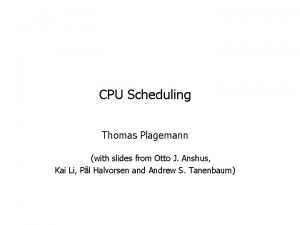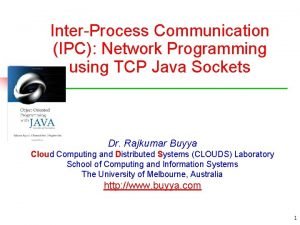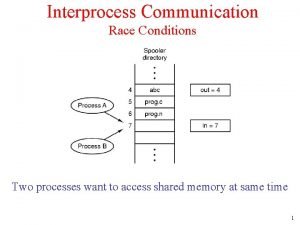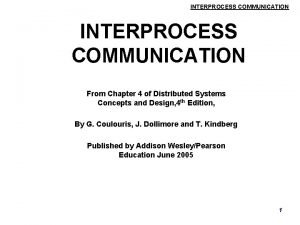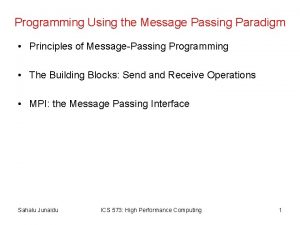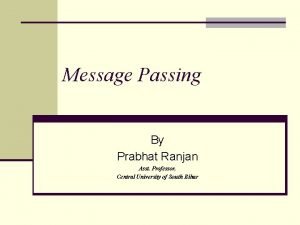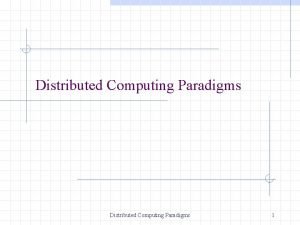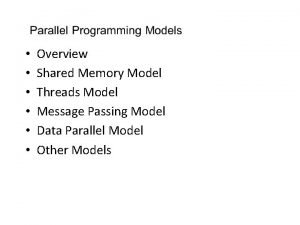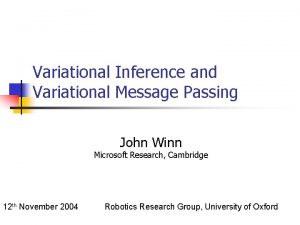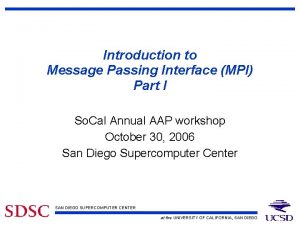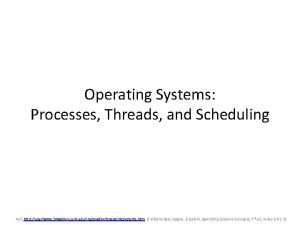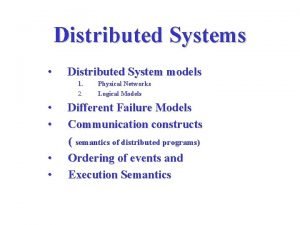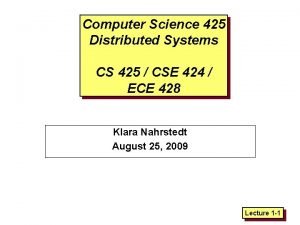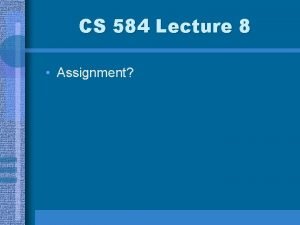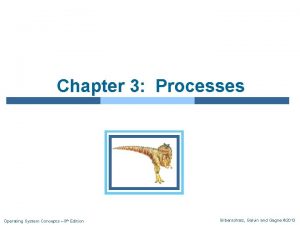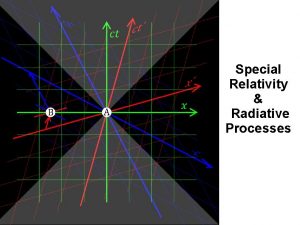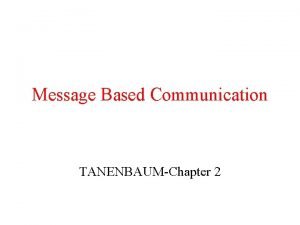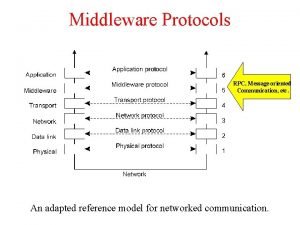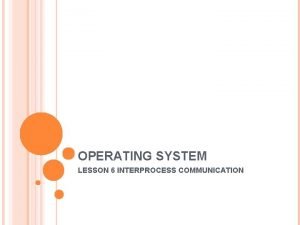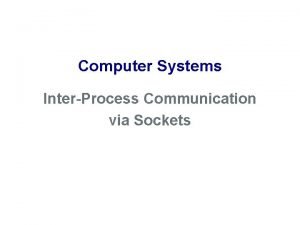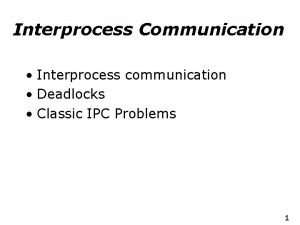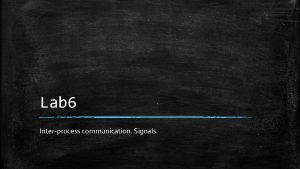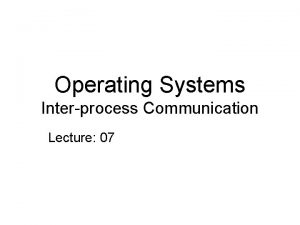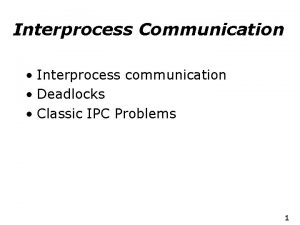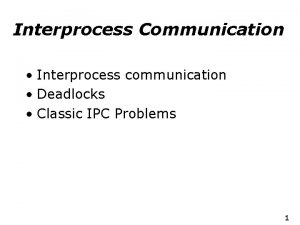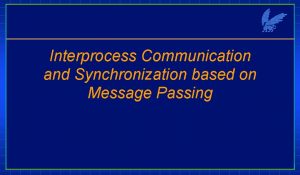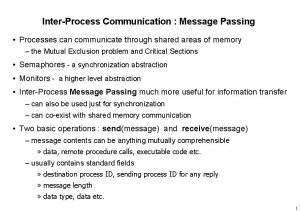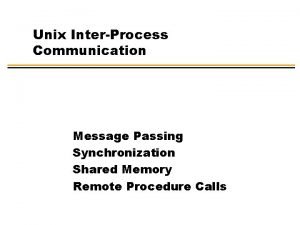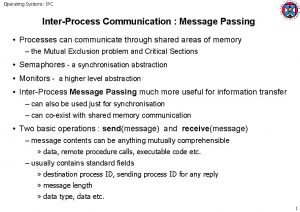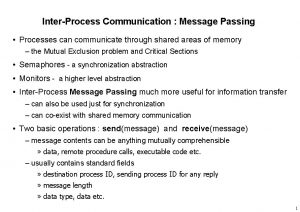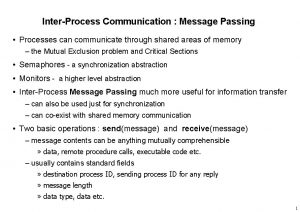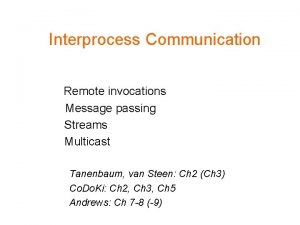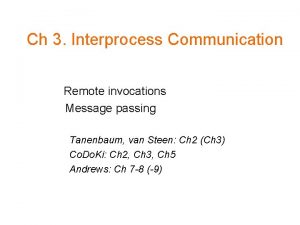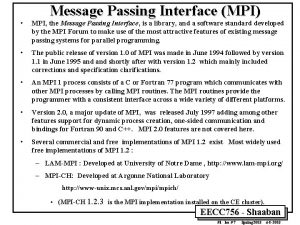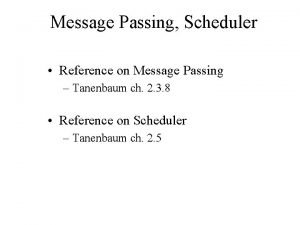InterProcess Communication Message Passing Thomas Plagemann With slides








































- Slides: 40

Inter-Process Communication: Message Passing Thomas Plagemann With slides from Pål Halvorsen, Kai Li, and Andrew S. Tanenbaum

Big Picture s tic cri sleep a nd wak eup n nd s nit ors ion eg r al mo ce a r co n ti io l l a ut m shared memory message passing communication? io s u c ex s exe t u m s hore semap

Message Passing API • Generic API – send( dest, &msg ) – recv( src, &msg ) • What should the “dest” and “src” be? – – – pid file: e. g. a (named) pipe port: network address, pid, etc no src: receive any message src combines both specific and any • What should “msg” be? – Need both buffer and size for a variable sized message

Issues • Asynchronous vs. synchronous • Direct vs. indirect • How are links established? • Can a link be associated with more than two processes? • How many links can there be between any pair? • What is the capacity of a link? • What is the size of a message? • Is a link unidirectional or bidirectional?

Asynchronous vs. Synchronous • Synchronous (blocking): msg operation, unblock thread, execute msg operation in another thread/kernel time – thread is blocked until message primitive has been performed – may be blocked for a very long time

Asynchronous vs. Synchronous • Asynchronous (non-blocking): msg operation, resume immediately execute msg operation in another thread/kernel time – – thread gets control back immediately thread can run in parallel other activities thread cannot reuse buffer for message before message is received how to know when to start if blocked on full/empty buffer? • poll • interrupts/signals • …

Asynchronous vs. Synchronous • Send semantic: • Receive semantic: – Synchronous • Will not return until data is out of its source memory • Block on full buffer – Synchronous • Return data if there is a message • Block on empty buffer – Asynchronous • Return as soon as initiating its hardware • Completion – Require application to check status – Notify or signal the application • Block on full buffer – Asynchronous • Return data if there is a message • Return null if there is no message

Buffering • No buffering – synchronous – Sender must wait until the receiver receives the message – Rendezvous on each message • Buffering – asynchronous or synchronous – Bounded buffer • Finite size • Sender blocks when the buffer is full • Use mesa-monitor to solve the problem? – Unbounded buffer • “Infinite” size • Sender never blocks

Direct Communication • Must explicitly name the sender/receiver (“dest” and “src”) processes • A buffer at the receiver – More than one process may send messages to the receiver – To receive from a specific sender, it requires searching through the whole buffer • A buffer at each sender – A sender may send messages to multiple receivers

Message Passing: Producer-Consumers Problem void producer(void) { void consumer(void) { while (TRUE) { … recv( producer, item ); produce item; … … consume item; send( consumer, item ); … } }

Message Passing: Producer-Consumers Problem with N messages

Indirect Communication • “dest” and “src” are a shared (unique) mailbox • Use a mailbox to allow many-to-many communication – Requires open/close a mailbox before using it • Where should the buffer be? – A buffer and its mutex and conditions should be at the mailbox

Using Message-Passing • What is message-passing for? – Communication across address spaces – Communication across protection domains – Synchronization • Use a mailbox to communicate between a process/thread an interrupt handler: fake a sender Keyboard Receive mbox

Process Termination • P waits for a message from Q, but Q has terminated – Problem: P may be blocked forever – Solution: • P checks once a while • Catch the exception and informs P • Send ack message • P sends a message to Q, but Q has terminated – Problem: P has no buffer and will be blocked forever – Solution: • Check Q’s state and cleanup • Catch the exception and informs P

Message Loss & Corruption • Unreliable service – best effort, up to the user to • Detection – Acknowledge each message sent – Timeout on the sender side • Retransmission – – Sequence number for each message Retransmit a message on timeout Retransmit a message on out-of-sequence acknowledgement Remove duplication messages on the receiver side

System V and Linux Mailboxes • Messages are stored as a sequence of bytes • System V IPC messages also have a type • Mailboxes are implemented as message queues sorting messages according to FIFO • Can be both blocking and non-blocking (IPC_NOWAIT) • The Linux related slides have some simplified (pseudo) code – – – Linux 2. 4. 18 several parts missing the shown code may block holding the queue lock waiting queues are more complex. . .

Mailboxes • Example: msgsnd(A, , . . . ) A B C D. . . msgrcv(B, , . . . ) OS-kernel

Messages in System V • Four system call – msgget( ) returns a message descriptor that designate a message queue – msgctl( ) control a message descriptor – msgsnd( ) send a message – msgrcv( ) receive a message • msgqid = msgget(key, flag) – Create a new message queue (entry) or to retrieve an existing message queue – key: a name chosen by user, represent a message queue. – flag: such as create flag bit with different permission – Return a kernel –chosen descriptor which points to the message queue

msgget • User calls msgget to creat a new descriptor • Kernel searches array of message queues to see if one with the key exists • If no entry with the given key: – Allocate a new queue structure – Initialize – Return identifier • Else: – Check permissions and return

Message Queues in System V • Kernel stores messages on a linked list (queue) per descriptor • msgqid is index into array of message queue headers • Each message queue (or IPC entry) has a permissions structure – Pointers to the first and last messages on a linked list – The number of messages and the total number of data bytes on the linked list – The maximum number of bytes of data that can be on the linked list – The process IDs of the last processes to send and receive messages – Time stamps of the last msgsnd, msgrc, and msgctl operation

Data Structures for Messages in System V Source: M. Bach: The Design of the Unix Operating System

msgsnd (msgqid, msg, count, flag) • msgqid descriptor of message queue returned by msgget • msg pointer to integer and character array • count size of the data array • flag what should be done if not enough internal bufferspace Source: M. Bach: The Design of the Unix Operating System

count = msgrcv(id, msg, maxcount, type, flag) id: message descriptor msg: the address of a user structure (message) maxcount: the size of the msg type: the message type that user wants to read flag: specifies what the kernel should do if no message are on the queue – count: the number of bytes returned to the user – – –

Source: M. Bach: The Design of the Unix Operating System

Msgctl(id, cmd, mstatbuf) • Query the status of a message descriptor, set its status, and remove a message queue • id identifies the message descriptor • cmd specifies the type of command • mstatbuf contains control parameters or returns result of a query

Linux Mailboxes • One msq_queue structure for each present queue: struct msg_queue { struct kern_ipc_perm q_perm; time_t q_stime; time_t q_rtime; time_t q_ctime; unsigned long q_cbytes; unsigned long q_qnum; unsigned long q_qbytes; pid_t q_lspid; pid_t q_lrpid; struct list_head q_messages; struct list_head q_receivers; struct list_head q_senders; }; /* /* /* access permissions */ last msgsnd time */ last msgrcv time */ last change time */ current number of bytes on queue */ number of messages in queue */ max number of bytes on queue */ pid of last msgsnd */ last receive pid */ • Messages are stored in the kernel using the msg_msg structure: struct msg_msg { struct list_head m_list; long m_type; int m_ts; struct msg_msgseg* next; }; /* message type */ /* message text size */ /* next pointer */ NOTE: the message is stored immediately after this structure - no pointer is necessary

Linux Mailboxes • Create a message queue using the sys_msgget system call: long sys_msgget (key_t key, int msgflg) {. . . create new message queue and set access permissions. . . } • To manipulate a queue, one uses the sys_msgctl system call: long sys_msgctl (int msqid, int cmd, struct msqid_ds *buf) {. . . switch (cmd) { case IPC_INFO: return info about the queue, e. g. , length, etc. case IPC_SET: modify info about the queue, e. g. , length, etc. case IPC_RMID: remove the queue }. . . }

Linux Mailboxes • Send a message to the queue using the sys_msgsnd system call: long sys_msgsnd (int msqid, struct msgbuf *msgp, size_t msgsz, int msgflg) { msq = msg_lock(msqid); . . . if ((msgsz + msq->q_cbytes) > msq->q_qbytes) insert message the tail of msq->q_messages *msgp, update msq else put sender in waiting senders queue (msq->q_senders) msg_unlock(msqid); . . . }

Linux Mailboxes • Receive a message from the queue using the sys_msgrcv system call: long sys_msgrcv (int msqid, struct msgbuf *msgp, size_t msgsz, long msgtyp, int msgflg) { msq = msg_lock(msqid); . . . search msq->q_messages for first message matching msgtype if (msg) store message in msgbuf *msgp, remove message from msgbuf *msgp, update msq else put receiver in waiting receivers queue (msq->q_receivers) msg_unlock(msqid); . . . } – the msgtyp parameter and msgflg flag determine which messages to retrieve: • = 0: return first message • > 0: first message in queue with msg_msg. m_type = msgtyp • > 0 & MSG_EXCEPT: first message in queue with msg_msg. m_type != msgtyp

Our Mailbox • We make it simpler than Linux – Deliver messages in FIFO order • Mailbox buffer space – Finite space • Main purpose: – Send – Receive • Maintenance: – – Init Open Close Statistics

Linux Pipes • Classic IPC method under UNIX: > ls -l | more – shell runs two processes ls and more which are linked via a pipe – the first process (ls) writes data (e. g. , using write) to the pipe and the second (more) reads data (e. g. , using read) from the pipe • the system call pipe( fd[2] ) creates one file descriptor for reading (fd[0]) and one for writing (fd[1]) - allocates a temporary inode and a memory page to hold data ls struct pipe_inode_info { wait_queue_head_t wait; char *base; unsigned int len; unsigned int start; unsigned int readers, writers; unsigned int waiting_readers, waiting_writers; unsigned int r_counter, w_counter; } more

Linux: Mailboxes vs. Pipes • Are there any differences between a mailbox and a pipe? – Message types • mailboxes may have messages of different types • pipes do not have different types – Buffer • pipes – one or more pages storing messages contiguously • mailboxes – linked list of messages of different types – Termination • pipes exists only as long as some have open the file descriptors • mailboxes must often be closed – More than two processes • a pipe often (not in Linux) implies one sender and one receiver • many can use a mailbox

Performance • Performance is an important issue (at least when sender and receiver is on one machine), e. g. : – shared memory and using semaphores – mailboxes copying data from source to mailbox and from mailbox to receiver • Can one somehow optimize the message passing?

Shared Memory in System V • Processes can communicate directly by sharing parts of their virtual address space • System calls for manipulating shared memory are similar to calls for messages • Read and write with standard calls

Shared Memory in System V (cont. ) • shmget create a new region of shared memory or returns an existing one – shmid = shmget (key, size, flag) • shmat logically attacheds a shared memory to the virtual address space of a process – virtaddr = shmat (id, addr, flags) • shmdt detaches a shared memory from the virtual address – shmdt(addr) • shmctl manipulate various parameters associated with the shared memory – shmctl(id, cmd, shmstatbuf)


Attaching Shared Memory

Remote Procedure Call • Message passing uses I/O • Idea of RPC is to make function calls • Small libraries (stubs) and OS take care of communication

Remote Procedure Call Implementation Issues: • Cannot pass pointers - call by reference becomes copy-restore • Marshaling - packing parameters • Weakly typed languages - client stub cannot determine size • Not always possible to determine parameter types • Cannot use global variables - may get moved to remote machine/protection domain

Summary • • • Many ways to perform IPC on a machine Direct message passing Message passing using mailboxes Pipes Shared memory RPC • To learn more about IPC in the Internet: – – INF INF 3190 5040 5050 5090 Data communication Open Distributed Processing Protocols and Routing in the Internet Advanced Topics in Distributed Systems
 Thomas plagemann
Thomas plagemann Interprocess communication in linux
Interprocess communication in linux Java interprocess communication example
Java interprocess communication example Message passing os
Message passing os Interprocess communication in os
Interprocess communication in os Race condition in interprocess communication
Race condition in interprocess communication Characteristics of inter process communication
Characteristics of inter process communication Android interprocess communication
Android interprocess communication Reader writer problem
Reader writer problem Principles of message passing programming
Principles of message passing programming Desirable features of message passing system
Desirable features of message passing system Divergence measures and message passing
Divergence measures and message passing Distributed computation paradigms
Distributed computation paradigms Message passing
Message passing Desirable features of good message passing system
Desirable features of good message passing system Message passing model
Message passing model Variational message passing
Variational message passing Message passing interface tutorial
Message passing interface tutorial Quick passing game
Quick passing game Message passing system in distributed system
Message passing system in distributed system System models in distributed system
System models in distributed system Message passing system in distributed system
Message passing system in distributed system Functional message
Functional message Message passing interface
Message passing interface Message passing os
Message passing os General vs special relativity
General vs special relativity A small child slides down the four frictionless slides
A small child slides down the four frictionless slides A hockey puck sliding on smooth ice at 4 m/s
A hockey puck sliding on smooth ice at 4 m/s Forensic anthropologist vs forensic pathologist
Forensic anthropologist vs forensic pathologist Business communication lecture slides
Business communication lecture slides Persuasive message strategy opening body closing
Persuasive message strategy opening body closing Positive messages in business communication
Positive messages in business communication Business communication chapter 3
Business communication chapter 3 Negative message definition
Negative message definition Transient vs persistent communication
Transient vs persistent communication Persuasive message in business communication
Persuasive message in business communication What is persuasive messages in business communication
What is persuasive messages in business communication Receipt-based transient synchronous communication
Receipt-based transient synchronous communication Communication game pass the message
Communication game pass the message Language
Language Area that separates two-way traffic on an expressway
Area that separates two-way traffic on an expressway
